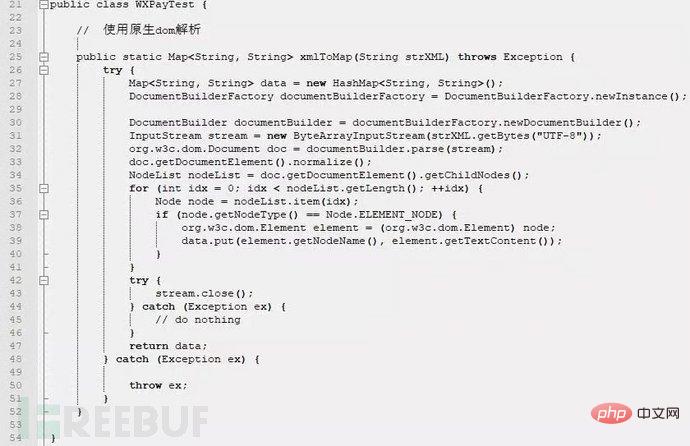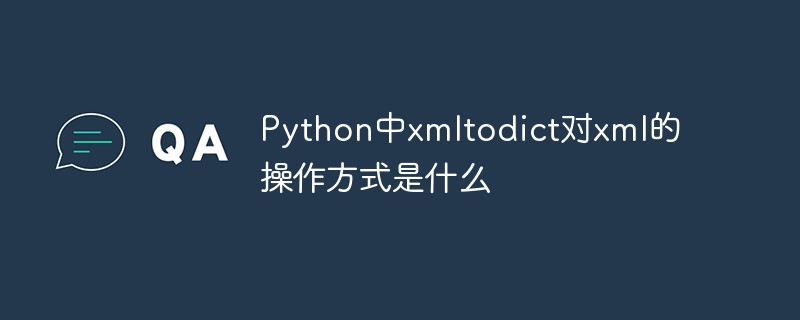Why is there Dom4j in the first place?
Because DOM consumes too much memory, and SAX can only read XML, but cannot add, delete, etc. So Dom4j appeared, which is more efficient and can also perform crud operations.
1. Introduction to DOM4J
Dom4j is a simple, flexible open source library. Dom4j was split off from the early developers of JDOM and then developed independently. Unlike JDOM, dom4j uses interfaces and abstract base classes. Although Dom4j's API is relatively complex, it provides better flexibility than JDOM.
Dom4j is a very excellent Java XML API with excellent performance, powerful functions and extremely easy to use. Many software now use Dom4j, such as Hibernate, including Sun's own JAXP, which also uses Dom4j.
To develop using Dom4j, you need to download the corresponding jar file of dom4j and import it into the project. Download address dom4j download
2.DOM4J case
still use our previous XML file:
<?xml version="1.0" encoding="utf-8" standalone="no"?><班级>
<学生 地址="香港">
<名字>周小星</名字>
<年龄>23</年龄>
<介绍>学习刻苦</介绍>
</学生>
<学生 地址="澳门">
<名字>林晓</名字>
<年龄>25</年龄>
<介绍>是一个好学生</介绍>
</学生></班级>This document is placed In the com.dom4j.test package.
Using DOM4J also requires obtaining the Document object representing the entire document, but this Document object is in the org.dom4j package.
Obtain the Document object in the main method as follows:
// 1.得到一个解析器SAXReader saxReader = new SAXReader();
// 2.指定解析哪个XML文件Document document = saxReader.read(new File("src/com/dom4j/test/myClass.xml"));Then we can write the corresponding method according to the needs and call it in the main method.
【1】Specify to read an element (read the first student’s information)
public static void read(Document document) { // 得到根元素
Element root = document.getRootElement(); // root.elements("学生"):表示取出root下的所有学生元素
// root.element("学生"):表示取出root下的第一个学生元素
Element student = root.element("学生"); // 取出属性
String address = student.attributeValue("地址"); // 取出各个子节点的值
String name = student.element("名字").getText();
String age = student.element("年龄").getText();
String intro = student.element("介绍").getText();
System.out.println(address);
System.out.println(name);
System.out.println(age);
System.out.println(intro);
}【2】Add element: Adding student information to the XML document
public static void add(Document document) throws Exception { // 首先我们来创建一个学生节点对象
Element student = DocumentHelper.createElement("学生");
Element name = DocumentHelper.createElement("名字");
name.setText("小强");
Element age = DocumentHelper.createElement("年龄");
age.setText("22");
Element intro = DocumentHelper.createElement("介绍");
intro.setText("是一个三好学生"); // 把三个子元素加到student节点下
student.add(name);
student.add(age);
student.add(intro); // 为学生添加属性
student.addAttribute("地址", "大理"); // 将学生节点添加到根节点下
document.getRootElement().add(student); // 更新xml文件,直接输出会出现中文乱码,要用OutputFormat
OutputFormat output = OutputFormat.createPrettyPrint(); // 设置输出的编码为utf-8
output.setEncoding("utf-8"); // 这里一定要用FileOutputStream字节流输出,不能用FileWriter,否则还会有乱码
XMLWriter xmlWriter = new XMLWriter(new FileOutputStream("src/com/dom4j/test/myClass.xml"), output);
xmlWriter.write(document);
xmlWriter.close();
}To add students to the XML document, you also need to write the Document object in the memory to the corresponding file at the end, otherwise all operations are only performed in the memory. , and will not be output to a file, which is similar to DOM.
We can still write this updated code as a separate method, as follows:
public static void update(Document document) throws Exception { // 更新xml文件,直接输出会出现中文乱码,要用OutputFormat
OutputFormat output = OutputFormat.createPrettyPrint(); // 设置输出的编码为utf-8
output.setEncoding("utf-8");
XMLWriter xmlWriter = new XMLWriter(new FileOutputStream("src/com/dom4j/test/myClass.xml"), output);
xmlWriter.write(document);
xmlWriter.close();
}[3] Add an element to the specified position
public static void addByIndex(Document document) throws Exception { // 创建一个元素
Element newStu = DocumentHelper.createElement("学生");
newStu.setText("王小明"); // 得到所有学生的list
List allStudent = document.getRootElement().elements("学生");
allStudent.add(1, newStu);
update(document);
}Here, you can actually add it directly to the obtained List and then update it. The List here is the List
# in the
java.util package [4] Delete an element or delete this Element attributes
Deleting an element is similar to DOM, in that the node is deleted through the corresponding parent node. For example, we want to delete the first student node:
public static void delete(Document document) throws Exception { // 找到该元素
Element student = document.getRootElement().element("学生"); // 删除元素的某个属性
student.remove(student.attribute("地址")); // 通过父节点删除节点
student.getParent().remove(student);
update(document);
}[5] Update element
For example, we want to add 1 to the age of all students, and add 1 to the age of all students. Change the address attribute to United States:
public static void updateAgeAndAddress(Document document) throws Exception {
Element root = document.getRootElement();
List<Element> list = root.elements(); for (Element element : list) { // 更新属性
element.addAttribute("地址", "美国"); // 更新年龄子节点的值
Element e_age = element.element("年龄"); int age = Integer.parseInt(e_age.getTextTrim());
e_age.setText(String.valueOf(age + 1));
}
update(document);
}Why is there Dom4j in the first place?
Because DOM consumes too much memory, and SAX can only read XML, but cannot add, delete, etc. So Dom4j appeared, which is more efficient and can also perform crud operations.
1. Introduction to DOM4J
Dom4j is a simple, flexible open source library. Dom4j was split off from the early developers of JDOM and then developed independently. Unlike JDOM, dom4j uses interfaces and abstract base classes. Although Dom4j's API is relatively complex, it provides better flexibility than JDOM.
Dom4j is a very excellent Java XML API with excellent performance, powerful functions and extremely easy to use. Many software now use Dom4j, such as Hibernate, including Sun's own JAXP, which also uses Dom4j.
To develop using Dom4j, you need to download the corresponding jar file of dom4j and import it into the project. Download address dom4j download
2.DOM4J case
still use our previous XML file:
<?xml version="1.0" encoding="utf-8" standalone="no"?><班级>
<学生 地址="香港">
<名字>周小星</名字>
<年龄>23</年龄>
<介绍>学习刻苦</介绍>
</学生>
<学生 地址="澳门">
<名字>林晓</名字>
<年龄>25</年龄>
<介绍>是一个好学生</介绍>
</学生></班级>The document is placed In the com.dom4j.test package.
Using DOM4J also requires obtaining the Document object representing the entire document, but this Document object is in the org.dom4j package.
Obtain the Document object in the main method as follows:
// 1.得到一个解析器SAXReader saxReader = new SAXReader();
// 2.指定解析哪个XML文件Document document = saxReader.read(new File("src/com/dom4j/test/myClass.xml"));Then we can write the corresponding method according to the needs and call it in the main method.
【1】Specify to read an element (read the first student’s information)
public static void read(Document document) { // 得到根元素
Element root = document.getRootElement(); // root.elements("学生"):表示取出root下的所有学生元素
// root.element("学生"):表示取出root下的第一个学生元素
Element student = root.element("学生"); // 取出属性
String address = student.attributeValue("地址"); // 取出各个子节点的值
String name = student.element("名字").getText();
String age = student.element("年龄").getText();
String intro = student.element("介绍").getText();
System.out.println(address);
System.out.println(name);
System.out.println(age);
System.out.println(intro);
}【2】Add element: Add a student information to the XML document
public static void add(Document document) throws Exception { // 首先我们来创建一个学生节点对象
Element student = DocumentHelper.createElement("学生");
Element name = DocumentHelper.createElement("名字");
name.setText("小强");
Element age = DocumentHelper.createElement("年龄");
age.setText("22");
Element intro = DocumentHelper.createElement("介绍");
intro.setText("是一个三好学生"); // 把三个子元素加到student节点下
student.add(name);
student.add(age);
student.add(intro); // 为学生添加属性
student.addAttribute("地址", "大理"); // 将学生节点添加到根节点下
document.getRootElement().add(student); // 更新xml文件,直接输出会出现中文乱码,要用OutputFormat
OutputFormat output = OutputFormat.createPrettyPrint(); // 设置输出的编码为utf-8
output.setEncoding("utf-8"); // 这里一定要用FileOutputStream字节流输出,不能用FileWriter,否则还会有乱码
XMLWriter xmlWriter = new XMLWriter(new FileOutputStream("src/com/dom4j/test/myClass.xml"), output);
xmlWriter.write(document);
xmlWriter.close();
}To add a student to the XML document, you also need to write the Document object in the memory to the corresponding file at the end, otherwise all operations are only performed in the memory. , and will not be output to a file, which is similar to DOM.
We can still write this updated code as a separate method, as follows:
public static void update(Document document) throws Exception { // 更新xml文件,直接输出会出现中文乱码,要用OutputFormat
OutputFormat output = OutputFormat.createPrettyPrint(); // 设置输出的编码为utf-8
output.setEncoding("utf-8");
XMLWriter xmlWriter = new XMLWriter(new FileOutputStream("src/com/dom4j/test/myClass.xml"), output);
xmlWriter.write(document);
xmlWriter.close();
}[3] Add an element to the specified position
public static void addByIndex(Document document) throws Exception { // 创建一个元素
Element newStu = DocumentHelper.createElement("学生");
newStu.setText("王小明"); // 得到所有学生的list
List allStudent = document.getRootElement().elements("学生");
allStudent.add(1, newStu);
update(document);
}Here, you can actually add it directly to the obtained List and then update it. The List here is the List
# in the
java.util package [4] Delete an element or delete this Element attributes
Deleting an element is similar to DOM, in that the node is deleted through the corresponding parent node. For example, we want to delete the first student node:
public static void delete(Document document) throws Exception { // 找到该元素
Element student = document.getRootElement().element("学生"); // 删除元素的某个属性
student.remove(student.attribute("地址")); // 通过父节点删除节点
student.getParent().remove(student);
update(document);
}[5] Update element
For example, we want to add 1 to the age of all students, and add 1 to the age of all students. Change the address attribute to United States:
public static void updateAgeAndAddress(Document document) throws Exception {
Element root = document.getRootElement();
List<Element> list = root.elements(); for (Element element : list) { // 更新属性
element.addAttribute("地址", "美国"); // 更新年龄子节点的值
Element e_age = element.element("年龄"); int age = Integer.parseInt(e_age.getTextTrim());
e_age.setText(String.valueOf(age + 1));
}
update(document);
} 以上就是XML—XML解析之DOM4J的内容,更多相关内容请关注PHP中文网(www.php.cn)!
 如何用PHP和XML实现网站的分页和导航Jul 28, 2023 pm 12:31 PM
如何用PHP和XML实现网站的分页和导航Jul 28, 2023 pm 12:31 PM如何用PHP和XML实现网站的分页和导航导言:在开发一个网站时,分页和导航功能是很常见的需求。本文将介绍如何使用PHP和XML来实现网站的分页和导航功能。我们会先讨论分页的实现,然后再介绍导航的实现。一、分页的实现准备工作在开始实现分页之前,需要准备一个XML文件,用来存储网站的内容。XML文件的结构如下:<articles><art
 XML外部实体注入漏洞的示例分析May 11, 2023 pm 04:55 PM
XML外部实体注入漏洞的示例分析May 11, 2023 pm 04:55 PM一、XML外部实体注入XML外部实体注入漏洞也就是我们常说的XXE漏洞。XML作为一种使用较为广泛的数据传输格式,很多应用程序都包含有处理xml数据的代码,默认情况下,许多过时的或配置不当的XML处理器都会对外部实体进行引用。如果攻击者可以上传XML文档或者在XML文档中添加恶意内容,通过易受攻击的代码、依赖项或集成,就能够攻击包含缺陷的XML处理器。XXE漏洞的出现和开发语言无关,只要是应用程序中对xml数据做了解析,而这些数据又受用户控制,那么应用程序都可能受到XXE攻击。本篇文章以java
 php如何将xml转为json格式?3种方法分享Mar 22, 2023 am 10:38 AM
php如何将xml转为json格式?3种方法分享Mar 22, 2023 am 10:38 AM当我们处理数据时经常会遇到将XML格式转换为JSON格式的需求。PHP有许多内置函数可以帮助我们执行这个操作。在本文中,我们将讨论将XML格式转换为JSON格式的不同方法。
 Python中xmltodict对xml的操作方式是什么May 04, 2023 pm 06:04 PM
Python中xmltodict对xml的操作方式是什么May 04, 2023 pm 06:04 PMPythonxmltodict对xml的操作xmltodict是另一个简易的库,它致力于将XML变得像JSON.下面是一个简单的示例XML文件:elementsmoreelementselementaswell这是第三方包,在处理前先用pip来安装pipinstallxmltodict可以像下面这样访问里面的元素,属性及值:importxmltodictwithopen("test.xml")asfd:#将XML文件装载到dict里面doc=xmltodict.parse(f
 Python中怎么对XML文件的编码进行转换May 21, 2023 pm 12:22 PM
Python中怎么对XML文件的编码进行转换May 21, 2023 pm 12:22 PM1.在Python中XML文件的编码问题1.Python使用的xml.etree.ElementTree库只支持解析和生成标准的UTF-8格式的编码2.常见GBK或GB2312等中文编码的XML文件,用以在老旧系统中保证XML对中文字符的记录能力3.XML文件开头有标识头,标识头指定了程序处理XML时应该使用的编码4.要修改编码,不仅要修改文件整体的编码,还要将标识头中encoding部分的值修改2.处理PythonXML文件的思路1.读取&解码:使用二进制模式读取XML文件,将文件变为
 xml中node和element的区别是什么Apr 19, 2022 pm 06:06 PM
xml中node和element的区别是什么Apr 19, 2022 pm 06:06 PMxml中node和element的区别是:Element是元素,是一个小范围的定义,是数据的组成部分之一,必须是包含完整信息的结点才是元素;而Node是节点,是相对于TREE数据结构而言的,一个结点不一定是一个元素,一个元素一定是一个结点。
 使用nmap-converter将nmap扫描结果XML转化为XLS实战的示例分析May 17, 2023 pm 01:04 PM
使用nmap-converter将nmap扫描结果XML转化为XLS实战的示例分析May 17, 2023 pm 01:04 PM使用nmap-converter将nmap扫描结果XML转化为XLS实战1、前言作为网络安全从业人员,有时候需要使用端口扫描利器nmap进行大批量端口扫描,但Nmap的输出结果为.nmap、.xml和.gnmap三种格式,还有夹杂很多不需要的信息,处理起来十分不方便,而将输出结果转换为Excel表格,方面处理后期输出。因此,有技术大牛分享了将nmap报告转换为XLS的Python脚本。2、nmap-converter1)项目地址:https://github.com/mrschyte/nmap-
 深度使用Scrapy:如何爬取HTML、XML、JSON数据?Jun 22, 2023 pm 05:58 PM
深度使用Scrapy:如何爬取HTML、XML、JSON数据?Jun 22, 2023 pm 05:58 PMScrapy是一款强大的Python爬虫框架,可以帮助我们快速、灵活地获取互联网上的数据。在实际爬取过程中,我们会经常遇到HTML、XML、JSON等各种数据格式。在这篇文章中,我们将介绍如何使用Scrapy分别爬取这三种数据格式的方法。一、爬取HTML数据创建Scrapy项目首先,我们需要创建一个Scrapy项目。打开命令行,输入以下命令:scrapys


Hot AI Tools

Undresser.AI Undress
AI-powered app for creating realistic nude photos

AI Clothes Remover
Online AI tool for removing clothes from photos.

Undress AI Tool
Undress images for free

Clothoff.io
AI clothes remover

AI Hentai Generator
Generate AI Hentai for free.

Hot Article

Hot Tools

PhpStorm Mac version
The latest (2018.2.1) professional PHP integrated development tool

Dreamweaver Mac version
Visual web development tools

Notepad++7.3.1
Easy-to-use and free code editor

MinGW - Minimalist GNU for Windows
This project is in the process of being migrated to osdn.net/projects/mingw, you can continue to follow us there. MinGW: A native Windows port of the GNU Compiler Collection (GCC), freely distributable import libraries and header files for building native Windows applications; includes extensions to the MSVC runtime to support C99 functionality. All MinGW software can run on 64-bit Windows platforms.

SublimeText3 Mac version
God-level code editing software (SublimeText3)







